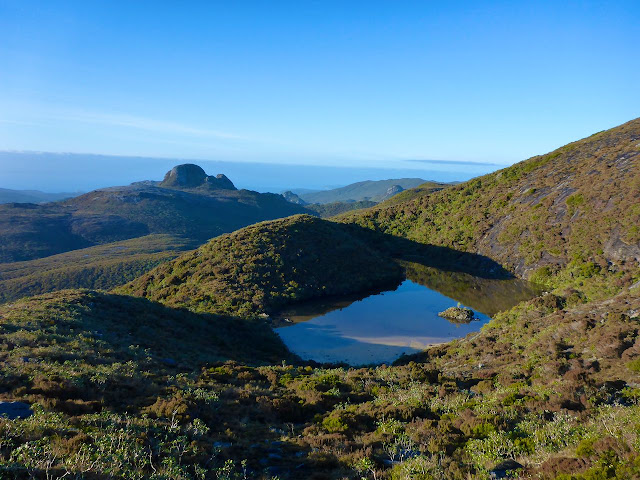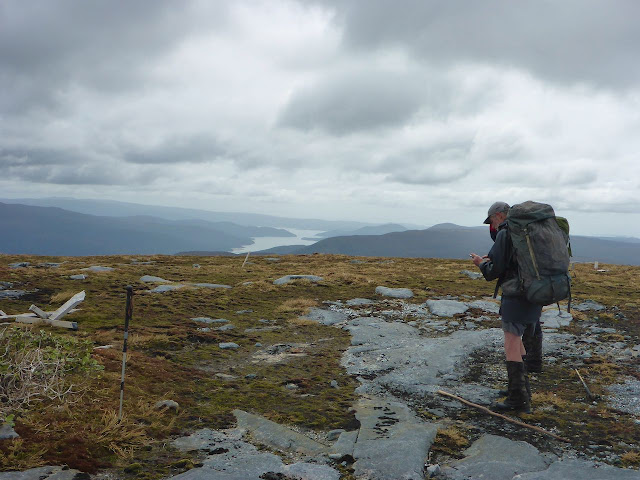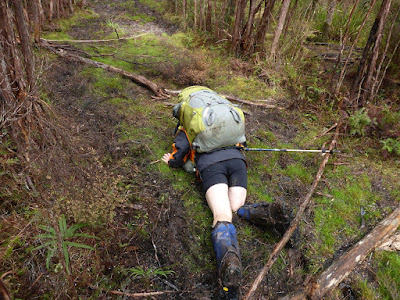The seas built as we came abreast of Lords River, now fully exposed to the SW swell. I glanced over at Ian, the skipper, who casually let the boat run off the waves and then gradually spun the wheel to the right to bring the nose into the oncoming swells. Belinda was a sickly white and embracing a sick bag pulled over her face with her head bent in supplication. Suddenly, David lurched up and staggered across the heaving floor for the rear deck. Great swells smashed with unfettered fury on the rocky promontories flinging spumes of white water high into the air . . .
Earlier Paula had told me that a mutual friend, Dave Henderson was planning a trip to Pegasus, a large protected bay at the southern end of Stewart Island. Belinda and I had kayaked there in 1997 but we had never walked the Tin Range so this was an opportunity. Our party was Gavin, David, Sally, Belinda and I. We had arranged to go there on 5th December with Richard Struthers’ party on the Aurora.
We all met early on a Saturday morning on the wharf at Bluff. Ian sailed in on his boat which is the old Stewart Island Ferry catamaran. The other team had a heap of gear to load. The forecast was for fine weather for the weekend only and then rain and wind for the rest of the week. I asked if we could be dropped off first so we could dash across the range before the oncoming storm.
Ian said conditions were average and I was glad we were not kayaking down in these big seas. Once we entered Whale Passage, the seas calmed as Ian steered up North Arm to our drop off at the bottom of Surveyor’s Track. I had my first look at the mountains curtained with olive green forest under a grey sky showing some breaks of blue. Ian rowed us ashore and once we negotiated the slippery foreshore rocks, we had lunch in a small clearing before starting up the partially overgrown track. The track is 4-5 kilometres long and climbs up to the 400m level and is easy to follow. Mining for tin began in the 1880s and continued intermittently until the 1930s. There were some huts on the track but these have long gone. The track meanders through manuka bush and took us to the open tops at 500m altitude. Then it was an easy walk northwards. There were patches of scrub but mostly it was straightforward travel
There were some great views of Gog, a steep rock peak to the south and many granite tors further along the range. Shafts of sun lit the ranges to the north. Later, we had some drifting cloud and drizzle but it was mostly clear. We could see both sides of Rakiura. The tops were boggy with few suitable campsites and very exposed to the prevailing westerly winds. We reached Granite Knob and turned it on the west side. A muddy track through the scrub on the north side took us down to a wide saddle. Ahead we could see Mt Allen and we planned to make for the tarn at 550m on the east side where there were some campsites. Gavin was powering ahead, sidling across the eastern slopes. There was a vague track here that led in the direction of the scrub. I wanted to stop and check the route but then Gavin disappeared into the scrub so we all followed. What ensued was a bitter struggle through impervious, gothic, cheerless subalpine scrub. Gavin, David and Belinda had disappeared and Sally and I had no idea where to go – up or down? The bush was covered in black slime and snatched at our clothes and snagged our packs. We seemed to be getting nowhere. When I checked my altimeter, I was appalled to find we were at 480m, well below the tarn. By now it was later in the day, 9.00 pm. Panic was welling up at the thought of having to bivouac in this stygian hell. Sally took over and forced a way upwards until we broke free near the coveted tarn. Gavin and David were already pitching their tent on some very wet bog beside the south end of the tarn so Belinda and I carried on around to the northern end where there was a white level sandy beach, perfect for our tent.
It was a windy evening but during the night it died and we awoke to a windstill clear day. We got underway early, climbing back onto the ridge to the north of us. Further along, was a drop to a saddle at 500m where we came across some bait stations. We saw evidence of feral cats and DOC are trying to eliminate them as they prey on Southern NZ Dotterel, an endangered species. We saw some of these fragile birds walking quickly on the open tops, quite unafraid of us.
Beyond Blaikies Hill, there was another big drop to a saddle at 500m before the final climb to Table Hill. We came across poles marking the route and more bait stations, then traps. Off to the west, we could see the white sands of Doughboy Bay and dead ahead was Mt Rakeahua. Table Hill is the northern end of the Tin Range but about 4-5 km of bush separates it from the Rakeahua River.
The poled route now went to the west over another hill before dropping down to an open tussock area to the north. After crossing this we followed the track into the scrub. DOC has allowed this to revert to nature so it became more difficult to follow. After a steep descent, we came to a wet clearing, following a small stream. This went on for some time. We took a wrong turn at a T junction of streams but quickly realized our error. Further on we had another steep drop and then into a surreal podocarp forest – a wonderland of graceful trees in the soft evening light. We struck the Southern Circuit Track, then over the bridge and along a very muddy, wet track to Rakeahua Hut which was empty and very welcome. It has been a long day and we had beat the weather.
Monday dawned fine and the plan was to head over to Doughboy Bay. This is a 17 km walk and a climb of 400m. David, Gavin and Sally started over first and Belinda and I followed at a slower pace. At first quite wet and muddy, it improved when the track sidled up the hillside among taller trees. The section climbing up to the tableland was very pleasant. However, above the forest, the track was back into mud holes. Here we encountered a big Kiwi foraging close to the track – Our national iconic bird – a wonderful sight. But it was gone all too soon. A cold wind blew from the SW and even though it was sunny, we felt chilled. Eventually, Doughboy hove into view and after a steep descent, we were back into the arcadian forest. Bright red rata flowers scintillated in the canopy of green. Then we were out on a dazzling, white beach with great blue rollers thundering in like a benediction. It has taken us 8 hours and I felt strangely tired. The new hut is at the northern end of the beach in the trees behind the dunes. The others had already camped beside it under the trees in an idyllic area.
We decided to spend another day at Doughboy. The weather was still fine and it was great to just relax and take in the positive energy of our surroundings – wind, sea, sky and bush. We went for walks on the beach, had a wash, dried some clothes and read. Near the hut was the famous cave that we had camped in when we were here last many years ago with our two young daughters.
On Wednesday, we left for Masons Bay, 14.5 km away. A good track left the northern end of the beach and climbed to 400m on Adams Hill. On top, it was very wet and muddy before descending into a more pleasant forest. We stooped for lunch along this section and later reached the white sands of Masons Bay where a furious gale was blowing. We all set our own pace and Sally was off. It was cold and blustery as we steadfastly marched along this endless beach. It was sad to see so much plastic rubbish lying around. It was nice to reach Mason Bay hut and the only occupant was a friendly Dutch girl.
Thursday saw us tramp over to Freshwater Hut which was empty. Later a father and son arrived. The Friday saw us carry over to North Arm where we camped. This is now part of the Rakiura Great Walk and should be booked for the Hut and campground but this is impractical if you are coming from Freshwater after doing the Southern or Northern Circuits. That night we had our first real rain of the trip. The next day we carried on to Oban and stayed at the Stewart Island backpackers. That evening we had dinner with Bill Watt, a kayaking guide there and discussed plans to run a skills course later in the summer. On Saturday, we boarded the Aurora again to take us across to Bluff.
Acknowledgment: First of all to Richard Struthers for allowing us to join his charter to Pegasus. Thanks to Ian Wilson of Aurora Charters who skillfully took us there and back. Thanks to my team – Gavin, Sally, David and Belinda. It was a pleasure meeting Bill Watt and sharing a meal with him.

































